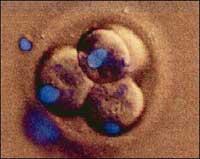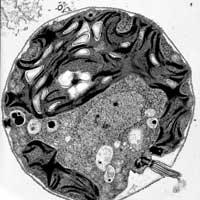Human cloning: where are we?
2001/11/27 Agirre Ruiz de Arkaute, Aitziber - Elhuyar Zientzia | Carton Virto, Eider - Elhuyar Zientzia | Imaz Amiano, Eneko - Elhuyar Zientziaren Komunikazioa | Galarraga Aiestaran, Ana - Elhuyar Zientzia
It is pointed out that the way has been opened to clone the human being, and it does not seem that the published results allow to predict this situation. In fact, Advanced Cell Technology has published that they have cloned the human embryo to get immunocompatible stem cells. Nothing more.

In this experiment only one cell has advanced; the rest has died quickly. The one who has advanced begins to divide the embryo in its path of development, but after forming 6 cells, the embryo has died. However, to start developing stem cells, the embryo should contain about a hundred cells. The success of this essay must be understood to its full extent. The human embryo has developed by cloning and has taken a step towards obtaining stem cells, but there is still a long way to go.
The truth is that some scientist has also questioned that the first human embryo has been cloned. In this line also go the press statements of Ian Wilmont himself, clone of the sheep Dolly. In his opinion, in this phase of development, the embryo should have more than 6 cells, so this cell group of poor development has not even become an embryo.
Obtaining totipotent stem cells (capable of becoming any tissue) with the patient's nuclear genome through the transfer of nucleus would be a huge boost to medicine, in which there is no doubt. But it's not the only way to get stem cells. At present it can also be performed by other techniques much more advanced than cloning, which have already allowed to develop blood cells, heart and liver. Therefore, the possibilities that these other techniques can offer should not be underestimated, especially as long as the way to achieve by cloning is still to be determined.
In addition, the media has included the embryo obtained by cloning in a woman's uterus and talked about the possibility of the baby being born. It must be said, however, that although legally and ethically possible, at the moment it is technically impossible. They have only achieved an undeveloped embryo. And even if they got it and put it in the womb, there would still be many difficulties unovercome. In fact, the cellular reprogramming necessary in cloning (methylation of the DNA of the reproductive cells and cellular “rejuvenation”) produces errors in the transmission of genetic information; enough errors so that the fetus does not develop properly and can die. For the moment, in the case of mammals, the success of reproductive cloning is 1%, hence only a few are born.
In short, they have been scientific-ethical-legal debates, but there are things that have been said of cloning man are still science-fiction because they are technically very difficult. In addition, research into stem cells is opening up other avenues. What is published in Herenegun is therefore a great advance, but not as much as it has been extended.
For more information:
Scientific articles published by Advanced Cell Technology: Articles published by
The Journal of Regenerative Medicine
Scientific American
Zientzi.net on human cloning:
What can stop human cloning from the human embryo obtained
by cloning by the stem cell?
The question of cloning from a biological point of view

Gai honi buruzko eduki gehiago
Elhuyarrek garatutako teknologia






